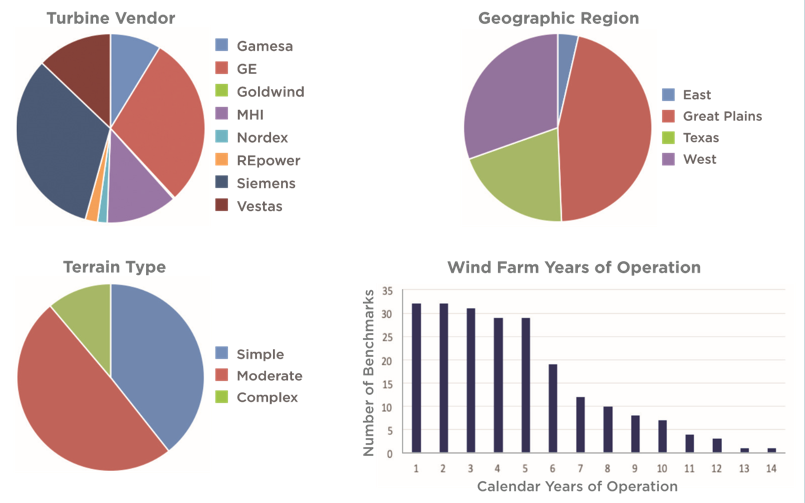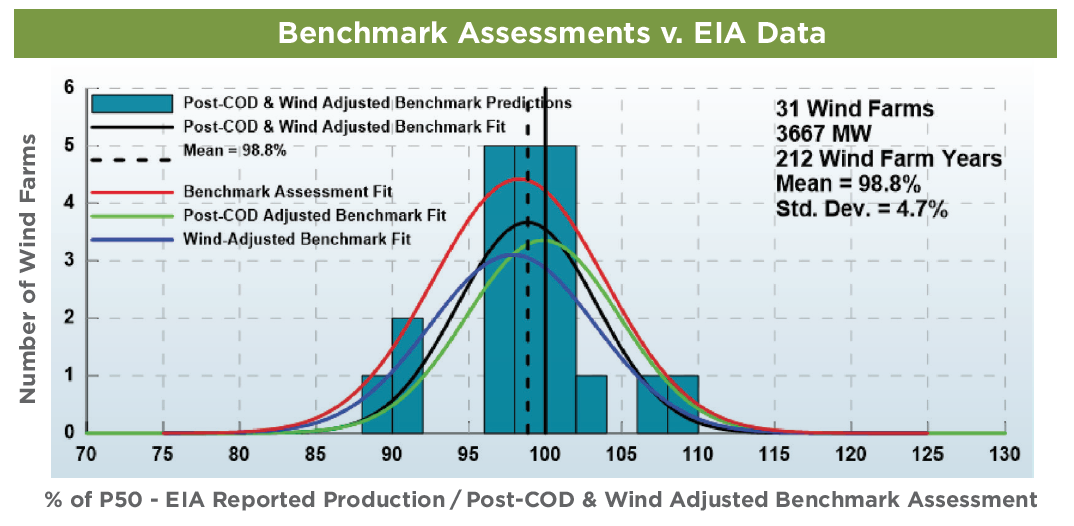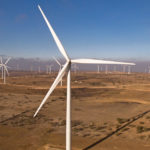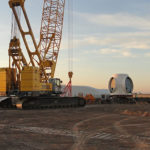Implications of a Wind Energy Resource Assessment for Wind Farm Project Development
- A change in long-term array hub-height wind speed of 0.1 m/s is typically equivalent to changing net annual energy by approximately 2%.
- Financial structure, capital costs, and MWh pricing help determine the sensitivity of sponsor return to changes in net capacity factor. For example, with a relatively low net capacity factor wind farm and a modest PPA price, a net capacity factor change of 100 basis points (e.g., from 36% to 37%) can cause a 150 basis point increase in a sponsor’s internal rate of return (e.g., from 12% to 13.5%, or a 12.5% increase).
To validate and document the quality of its wind energy resource assessment (WERA) practices, ArcVera Renewables engaged in a benchmark study comparing pre-construction assessments using its current practices to postconstruction energy production. The company completed a report of the study, Wind Energy Resource Assessment Benchmark, January 25, 2019. ArcVera finds that its current WERA techniques are accurate on average, with lower variation than older techniques. The results of the study show that ArcVera’s current WERA techniques are accurate to within 1%, on average, of reported project P50 energy production, with lower project performance variation.
Details and Highlights of the Report
- For the comparison between pre-construction assessments and reported energy production, ArcVera used a dataset based on 21 projects in the U.S. with a total of 2134 MW of combined nameplate capacity and operating for a total of 153 calendar wind farm years. Commercial operations dates vary from 2003 to 2012.
- ArcVera also completed energy assessments for 10 more projects as part of the U.S. National Renewable Energy Laboratory (NREL) Wind Plant Performance Prediction (WP3) validation study. When combined with the 21 ArcVera projects, the database represents a total of 3667 MW of combined nameplate capacity for a total of 212 calendar wind farm years.
- Additional information about the benchmarked projects is shown in Figure 1

Figure 1: Summary of Benchmark Project Sites
- ArcVera conducted the benchmark using its current practices, including:
-
- Updated and standardized meteorological data analysis techniques
- Expanded and routine use of MERRA-2 and other virtual reference data
- Incorporation of high-resolution, full-physics, mesoscale wind flow modeling
- Combined or ensemble application of wind flow and wake loss models
- A more quantitative check for risk of underperforming power curve
- More rigorously defined and quantified site-specific gross-to-net loss and uncertainty factors
- ArcVera compared the original assessments to benchmark assessments using:
-
- The original U.S. Energy Information Administration (EIA) annual energy production totals with no adjustments
- The same EIA data with adjustments for off-taker curtailment, new wind farm wakes, turbine power performance and bat curtailment
- The same EIA data with adjustments for interannual wind variability
- The results in the full report include a comparison of individual years of net production (MWh) and project lifetime mean annual production.
- The results of the benchmark study for the 21 ArcVera and 10 NREL WP3 projects using current ArcVera practices are shown in Figure 2.

Figure 2: Benchmark Study Results
- Conclusion: With an average project performance bias close to zero and decreased standard deviation, the improved ArcVera processes are shown through this benchmark study to deliver improved wind energy resource assessments.
- The improved ArcVera wind energy resource assessment methodology yields an average project performance of 98.8% for 31 projects with a decreased standard deviation of 4.7%. As estimates of grid curtailment losses (which are typically 1 to 1.5%) are not corrected for in most of these Benchmark assessments, the overall project performance is effectively 100%.
- These data will be updated and expanded each year as new production data becomes available.
About ArcVera Renewables:
ArcVera Renewables provides expert insights, targeted analysis and reporting for prospecting, development, sponsor financing, portfolio transactions, post-construction operational analysis, and repowering. The company’s experienced team of atmospheric scientists, data analysts, and engineers are known for their expertise, precision, responsiveness, and reliability. Services in measurement and analysis comprise: resource measurement, measurement campaign strategy, instrument specification, design, IEC standards and placement of meteorological station(s) and remote sensors.
To obtain the ArcVera Renewables report:
Wind Energy Resource Assessment Benchmark, completed January 25, 2019, is available upon request by sending email to publications@arcvera.com




